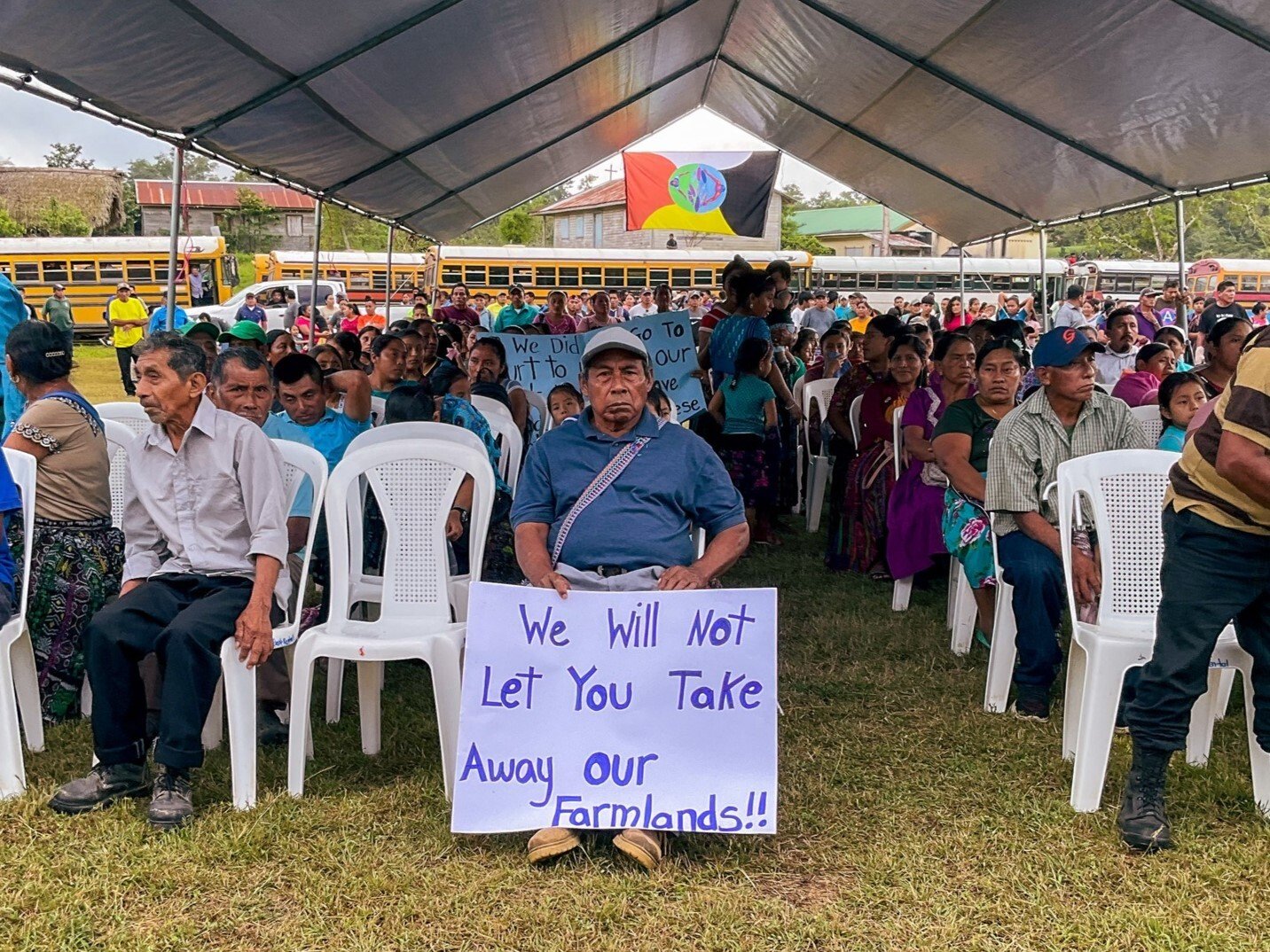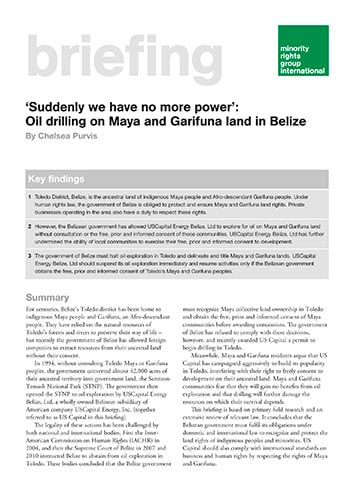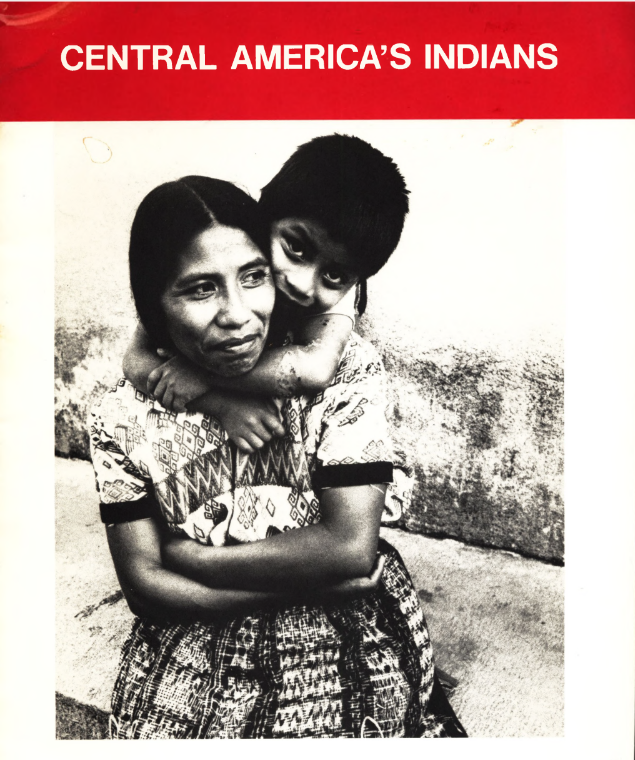Maya in Belize
-
Profile
The Maya are the country’s indigenous population. They are the direct descendants of the original indigenous inhabitants of the Yucatán peninsula. The three Maya groups in Belize are the Yucatec, Mopan, and Q’eqchi’ Maya.
The Yucatec originated from Yucatán Peninsula in Mexico and arrived in Belize in the mid-nineteenth century as refugees from the Guerra de Castes (‘Caste War’). They now reside in the Corozal, Orange Walk, and Cayo Districts. Today the Yucatec Maya are primarily English and Spanish speakers.
The Mopan Maya moved to Belize in 1886 from the Petén region of Guatemala to escape taxation and forced labour. Mopan Maya settlements are located in San Antonio village in Toledo District and there are also other villages in the Cayo District.
Q’eqchi’ Maya arrived in Belize in the 1870s in order to escape enslavement by German coffee growers in Verapaz, Guatemala. They settled in the lowland areas along rivers and streams and established 30 small isolated villages throughout Toledo district. Because of their isolation, Q’eqchi’ have remained the country’s poorest and most neglected minority.
Belize’s Maya are mainly subsistence farmers. The Maya have experienced continued encroachment on their lands by non-indigenous settlers and large scale logging and petroleum enterprises which threaten their traditional territories and way of life.
Historical context
Original Maya
The country now known as Belize was originally a key part of the ancient Maya civilization, which began expanding around 1000 BCE and flourished until about 900 AD.
Mayan history shows strong evidence of connections to the more ancient Olmec (Xhi) civilization of Southern Veracruz in Mexico.
The physical ‘boundaries’ of the ancient Mayan empire spanned the countries of modern day Guatemala, Belize, the western parts of Honduras and El Salvador and the five Mexican states of Yucatán, Quintana Roo, Tabasco, Campeche and Chiapas.
Ancient Maya cities established far-reaching production and trade networks as well as temples and religious centres and developed writing, mathematics and astronomy, which allowed them to monitor other planets and predict eclipses.
Maya territory in Belize supported an estimated population of 1 to 2 million people and large cities such as Xunantunich Caracol, and Lamanai.
Belize was the home of the earliest Maya settlements. The earliest known settled community in the Maya world is Cuello in the Orange Walk District of Belize. Archaeologists have found evidence that trace Cuello to as far back as 2000 BC.
Belize was also an important trading centre for the entire Maya area. Some major trading centres were Moho Caye, Santa Rita, Ambergris Caye and Wild Cane Caye. Other civic centres in Belize include Altun Ha, Lubaantun, and El Pilar.
There were still many Maya in Belize by the 16th and 17th centuries. In the 19th century their numbers were augmented by the exodus caused by the expropriation of lands in Guatemala to establish agricultural export enterprises.
Maya today
Of the 28 Maya ethnic groups that exist in Mexico and Central America, those that are currently present in Belize are the Yucatec, Mopan and Q’eqchi’ Maya who are located in the south of the country.
Although the Mopan and Q’eqchi’ historically have been characterized under the general term Maya, recently some leaders have began to assert that they should be re-identified as the Masenal (‘common people’).
The Maya of southern Belize have experienced a harsh history of colonization and continue to be deprived of their human rights, especially in relation to the lands and resources that they have traditionally used and occupied.
In October of 2000, Maya leaders and government signed the ‘Ten Points of Agreement,’ in which the government recognized Maya rights over traditional lands and resources in general terms and committed to embark on a set of initiatives to make that recognition effective. This is still mostly unrealized.
In July of 2001, another framework agreement was signed dealing with issues concerning ongoing oil and logging concessions.
In August of 2002, a further round of negotiations began with the goal of addressing outstanding concerns within the agreed framework. The result was again a commitment on the part of the government to amend existing legislation in order to establish a moratorium on the issuing of logging permits and other activities that affect Maya traditional lands without prior consultation with Mayan communities.
However this moratorium was not all encompassing but limited to a corridor stretching some three kilometres on either side of a renovated main thoroughfare through Maya territory (the Southern Highway). This road project itself has prompted great concern.
Current issues
The current issues affecting the indigenous minority of Belize are mainly related to continued encouragement by the government of Belize of non-indigenous settlement, large-scale logging and petroleum development on traditional Maya lands, despite stated intentions to address these matters. This not only continues to threaten Maya communities but also the natural environment upon which their culture and livelihood depends.
This prompted Maya communities to begin working with local Belizean attorneys and support groups and to reach out internationally to organizations such as the Indigenous Peoples Law and Policy (IPLP) Program at the University of Arizona, the Indian Law Resource Center, and the University of Toronto Human Rights Law Clinic for legal assistance. Their aim was to initiate international litigation in support of their outstanding claims.
Background
In 1994, without consulting Toledo Maya or Garifuna people, the government converted almost 42,000 acres of their ancestral territory into government land, the Sarstoon-Temash National Park (STNP). The government then opened the STNP to oil exploration by US Capital Energy Belize, Ltd, a wholly owned Belizean subsidiary of American company US Capital Energy, Inc.
In late 1996 following the granting of concessions by the Belize Ministry of Natural Resources to two multinational companies to log over 500,000 acres of rain forest in the Toledo District, the Toledo Maya Cultural Council (TMCC), representing 37 Maya indigenous communities, filed a claim in the Supreme Court of Belize challenging the constitutionality of the government’s actions and seeking titles to their traditional lands and resources.
Several years after filing, this case remained unresolved with the government ignoring deadlines and requests for the production of documents.
As a result of the failure of domestic litigation the Maya communities submitted a petition to the Inter-American Commission on Human Rights (IACHR) in 1998, asking the Commission to use its powers under the OAS Charter to intervene and either mediate a resolution or declare Belize in violation of the relevant human rights laws.
Commission visit
Following an on-site visit to Belize and the Maya communities in 2001, the Commission expressed concern over the situation and reinitiated earlier efforts to mediate a negotiated settlement to the land and resource-rights issues.
These mediation efforts failed prompting the Commission to issue a preliminary report on the case in late 2003, finding Belize in violation of relevant human rights law for having permitted logging and oil development on Maya traditional lands and for failing to take affirmative measures to recognize and protect Maya rights over those lands.
The Commission’s preliminary report was initially submitted to Belize as a confidential document, in accordance with the Commission’s rules of procedure. However the Belize government subsequently voluntarily made the report public with the Commission’s permission.
Commission findings
The IACHR report is unprecedented in its far-reaching affirmation of the human rights of indigenous peoples under international law as related to lands and resources. The report builds upon the jurisprudence of the Inter-American Court of Human Rights in the groundbreaking Awas Tingni case (see Nicaragua).
In its report the Inter-American Commission held that indigenous peoples have property rights over their traditional lands and resources under international human rights law, apart from whether or not those rights are recognized under domestic law.
The Commission found that the Maya have collective rights to all the lands they have traditionally used and occupied, not just those within reserve or village boundaries.
It also confirmed that international law requires the government of Belize to set the boundaries of the lands the Maya have used and lived on, and to legally recognize and protect Maya communal property rights.
Furthermore, the Commission stated that the government of Belize must consult with Maya communities and obtain their informed consent before taking any actions that affect their traditional lands.
According to the Commission, the government of Belize violated the provisions of the American Declaration on the Rights and Duties of Man that affirm the rights to property and equality before the law by failing to protect Maya lands and resources and by failing to obtain Maya consent for logging concessions and other activities on their traditional lands.
In addition, the Commission argued that the government violated Maya rights to judicial protection by failing to adequately address Maya grievances through the failure of the domestic legal process.
Status
In 2007, the Supreme Court of Belize ordered the government to recognize Maya land rights, demarcate and title their land, and cease and abstain from interfering with their right to property. The government never appealed this decision. In 2010, the Supreme Court clarified that the 2007 judgment applied to Maya throughout Toledo and issued an injunction prohibiting concessions throughout Toledo. The Government appealed this decision to the Court of Appeal.
Despite some progress, the future of indigenous land rights in Toledo remains uncertain. On 25 July 2013, the Court of Appeal affirmed Maya land rights. In a 2-1 decision, the Court found that Maya of Toledo possessed rights to land and resources in Southern Belize based on their longstanding use and occupancy.
The Court further concluded, however, that the Supreme Court erred in finding that the Constitution of Belize imposes a positive obligation on the government to adopt affirmative measures to protect the rights of the respondents. Based on this conclusion, the Court of Appeal struck out the Supreme Court’s injunction against government interference with Maya land. The Court also dismissed the Maya people’s cross-appeal for damages. The government maintains that the STNP is government property, and it has permitted US Capital to continue oil exploration in the park.
The UN Committee on the Elimination of Racial Discrimination has indicated to the government of Belize that the Committee ‘deplores the fact that the State party appears to continue to deny customary land rights to the Maya people.’ The UN Human Rights Committee in March 2013 expressed concern about allegations that Belize was not complying with the decision of the IACHR and Supreme Court of Belize, and it instructed Belize to desist from awarding oil concessions on Maya land. The IACHR recently expressed its concern about the government’s continued failure to recognize Maya land rights, stating that oil exploration in Toledo without consultation would represent a violation of human rights.
In July 2013, more than 300 leaders of Maya villages met to learn about the Court of Appeals decision and voted to appeal to the Caribbean Court of Justice (CCJ), the court of last resort for Belize. Sarstoon-Temash Institute for Indigenous Management (SATIIM)in July 2013 filed its own lawsuit at the Supreme Court and has requested an injunction to stop US Capital from operating in STNP. This was heard in October 2013, and judgment was delivered at the end of March 2014. In a strong ruling, the Supreme Court held that government permission to commence oil drilling and construct roads in the national park by US Capital Energy was unlawful on the basis that the permission was granted without the government seeking the free, prior and informed consent of the affected Maya communities. However, a few weeks after issuing this order it was modified to provide that the government needed simply to make good faith attempts to obtain consent rather than actually obtaining it. The Supreme Court also went on to order mediation between the parties.
In May 2015, the CCJ affirmed the rights of the Maya people of Southern Belize to their customary and traditional lands. The ruling included an agreement between the Maya and representatives of the government of Belize and, as previously held by Belize’s Court of Appeal, confirmed that their traditional land is property under the Constitution. The CCJ accepted the government’s undertaking to put in place, in full consultation with the Maya, the necessary administrative and legal provisions to enable the demarcation and registration of communal lands, and their protection from incursion by outsiders. Importantly, given the failure by the government to take any steps to implement earlier judgments in favour of the Maya, the CCJ said that it would oversee the government’s compliance, with both sides due to report back on implementation of a customary land rights system. The CCJ reserved its decision on the issue of compensation for damages for the Maya. Unfortunately, by 2017, there was still little sign of actual implementation. So, as a way of commemorating the International Day of the World’s Indigenous Peoples and the Tenth Anniversary of the UN Declaration on the Rights of Indigenous Peoples, on 9 August 2017, SATIIM took matters into their own hands and launched a Maya land rights registry in order to implement the CCJ findings.
Meanwhile, in November 2016, a SATIIM patrol to monitor deforestation was stopped by Guatemalan military, who said that they could only proceed under Guatemalan military escort. The incident drew further attention to the Belize-Guatemala border dispute and how it also affects local community land rights enforcement.
Updated December 2017
Related content
Latest
-

9 February 2024
Government of Belize must respect Maya land rights
Minority Rights Group urges the Belizean government to respect the human and property rights of the Maya People of southern Belize and…
Reports and briefings
View all-
11 September 2013
‘Suddenly we have no more power’: Oil drilling on Maya and Garifuna land in Belize
For centuries, Belize’s Toledo district has been home to indigenous Maya people and Garifuna, an Afro-descendant people. They have…
-
1 July 1987
The Amerindians of South America
For over 20,000 years a wealth of many cultures flourished in South America, both in the high Andean mountains and the lowland jungles and…
-
1 April 1984
Central America’s Indians
In Latin America today we find one of the largest remnants of colonialism in the world. The concept “Indian” itself is, of course, a…
-
Our strategy
We work with ethnic, religious and linguistic minorities, and indigenous peoples to secure their rights and promote understanding between communities.
-
-


